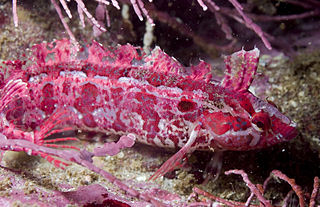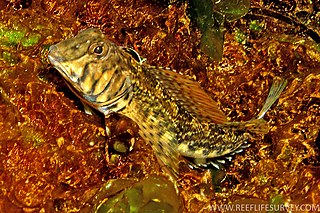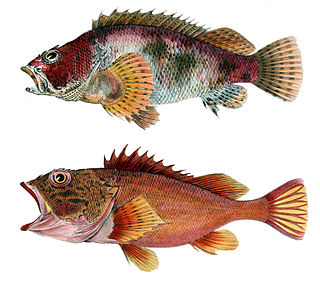
Clinidae is a family of marine fish in the order Blenniiformes within the series Ovalentaria, part of the Percomorpha. Temperate blennies, the family ranges from the Atlantic, Pacific, and Indian Oceans, in both the Southern and Northern Hemispheres. The family contains about 86 species in 20 genera, the 60-cm-long giant kelpfish being the largest; most are far smaller.

Blenny is a common name for many types of fish, including several families of percomorph marine, brackish, and some freshwater fish sharing similar morphology and behaviour. Six families are considered "true blennies", grouped under the order Blenniiformes; its members are referred to as blenniiformids. About 151 genera and nearly 900 species have been described within the order. The order was formerly classified as a suborder of the Perciformes but the 5th Edition of Fishes of the World divided the Perciformes into a number of new orders and the Blenniiformes were placed in the percomorph clade Ovalentaria alongside the such taxa as Cichliformes, Mugiliformes and Gobiesociformes.

The large kelpfish, the Eastern kelpfish, hiwihiwi, surgefish or kelpfish, is a species of marine ray-finned fish, a kelpfish belonging to the family Chironemidae. It is found in southern Australia, and off the North Island of New Zealand, at depths down to 30 m.

Chironemus is a genus of marine ray finned fish, commonly known as kelpfishes, belonging to the family Chironemidae. They are found in the temperate waters of the Southern Pacific Ocean.
A crevice is a fracture or fissure in rock.
Emblemaria caycedoi, the Colombian blenny, is a species of chaenopsid blenny found around Venezuela and Isla de Providencia, Colombia, in the western central Atlantic Ocean. The specific name honours the young marine biologist Enrique Caycedo Lara, who died in 1978.
Emblemariopsis bottomei, the Shorthead blenny or the Midnight blenny, is a species of chaenopsid blenny found in coral reefs in the western central Atlantic ocean. It can reach a maximum length of 3 centimetres (1.2 in) SL. The specific name honours Peter Bottome, although who this is, is not specified but it may possibly be the Venezuelan businessman Peter Bottome Deery (1937-2016).

Emblemariopsis diaphana, the glass blenny, is a species of chaenopsid blenny found in coral reefs in the Florida Keys, USA, in the western central Atlantic ocean. It can reach a maximum length of 4 centimetres (1.6 in) TL. The specific name refers to this species being "largely translucent" in life, although this is lost in preserved specimens. E. diaphana is the type species of the genus Emblemariopsis.

Gibbonsia is a genus of clinids native to the eastern Pacific ocean. The name of this genus honours the American naturalist, physician and founder member of the California Academy of Sciences, William P. Gibbons (1812-1897).

Gibbonsia elegans, the spotted kelpfish, is a species of clinid native to subtropical waters of the Pacific Ocean from central California, U.S. to southern Baja California, Mexico. It prefers subtidal rocky habitats with seaweed down to a depth of about 56 metres (184 ft). This species can reach a maximum length of 16 centimetres (6.3 in) TL. This species feeds on benthic crustaceans, gastropods, and polychaete worms. The genus Gibbonsia is named after Dr. William P. Gibbsons who was a naturalist in the California Academy of Science. It is found in three different colors depending on their habitat. Males and females do not show sexual dimorphism.

Gibbonsia metzi, the striped kelpfish, is a species of clinid native to the Pacific coast of North America from British Columbia, Canada, to Baja California, Mexico. It can be found in tide pools and in kelp beds down to a depth of about 9 metres (30 ft). This species can reach a maximum length of 24 centimetres (9.4 in) TL. The can also be found in the aquarium trade. This species feeds primarily on polychaete worms. The specific name honours the geneticist Charles W. Metz (1889-1975) of the University of Pennsylvania.

Gibbonsia montereyensis, the Crevice kelpfish, is a species of clinid found along the Pacific coast of North America from British Columbia, Canada, to Baja California, Mexico where it prefers areas close to the shore amongst algae. This species can reach a maximum length of 11 centimetres (4.3 in) TL. They tend to be red or orange with white spots or stripes, although other colors and patterns have been observed. This species feeds primarily on polychaete worms. They are poorly studied.
Alloclinus holderi, the island kelpfish is a subtropical species of labrisomid blenny native to the eastern Pacific Ocean from Santa Cruz Island, California, to Baja California. This species inhabits rocky areas and can be found down to about 49 m (161 ft). It can reach a length of 10 cm (3.9 in). The specific name honours the American naturalist, conservationist and author Charles Frederick Holder (1851-1915).

Auchenionchus is a genus of labrisomid blennies endemic to the Pacific waters off of Chile,

Starksia is a genus of labrisomid blennies native to the western Atlantic Ocean and the eastern Pacific Ocean. Their typical length is 2 cm (0.79 in) SL. The generic name honours the American ichthyologist Edwin Chapin Starks (1867-1932) of Stanford University for his work on Pacific coastal fishes. As a genus Starksia is distinguished from other labrisomids by their scaled bodies, two obvious soft rays in the pelvic fin and the male's have an intromittent organ which is near to or attached to the first spine of their anal fins, which is also somewhat separated from the fin.

Lepidoblennius marmoratus, known commonly as the western jumping blenny, is a species of triplefin blenny in the genus Lepidoblennius. It was first described by William John Macleay in 1878.

Sebastiscus is a genus of marine ray-finned fish belonging to the subfamily Sebastinae part of the family Scorpaenidae. These fishes are native to the western Pacific Ocean. They are collectively called sea ruffes and resemble the rockfishes in the genus Sebastes, but are usually smaller and have a different pattern.

Sebastiscus marmoratus, the sea ruffe, false kelpfish or dusky stingfish, is a species of marine ray-finned fish belonging to the subfamily Sebastinae, the rockfishes, part of the family Scorpaenidae. It is found in the Western Pacific from southern Japan to the Philippines. It has also been sighted twice in Australia.
Brockius is a genus of labrisomid blennies from the waters of the eastern Pacific and the western Atlantic where they are associated with reefs and seaweed-covered rocks.












